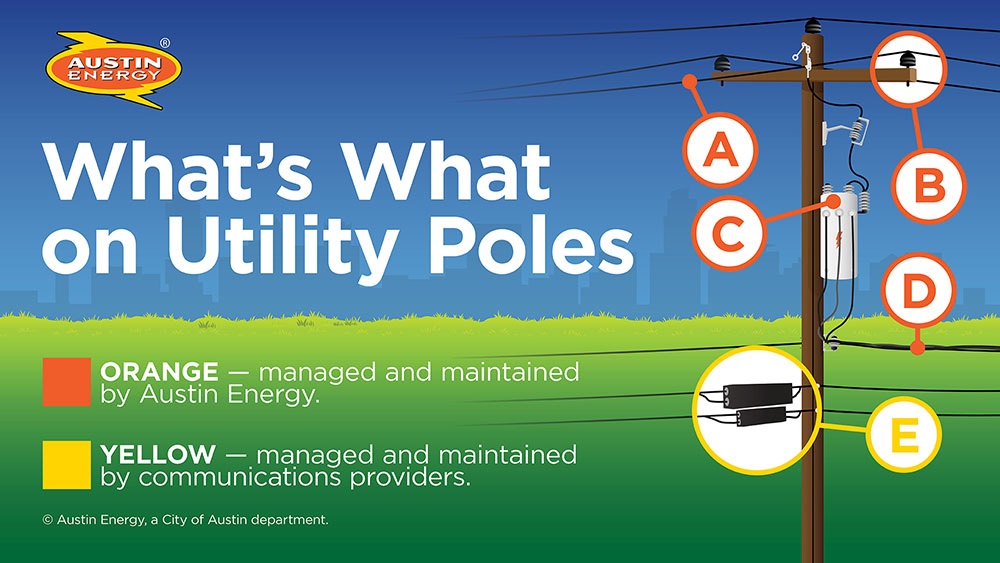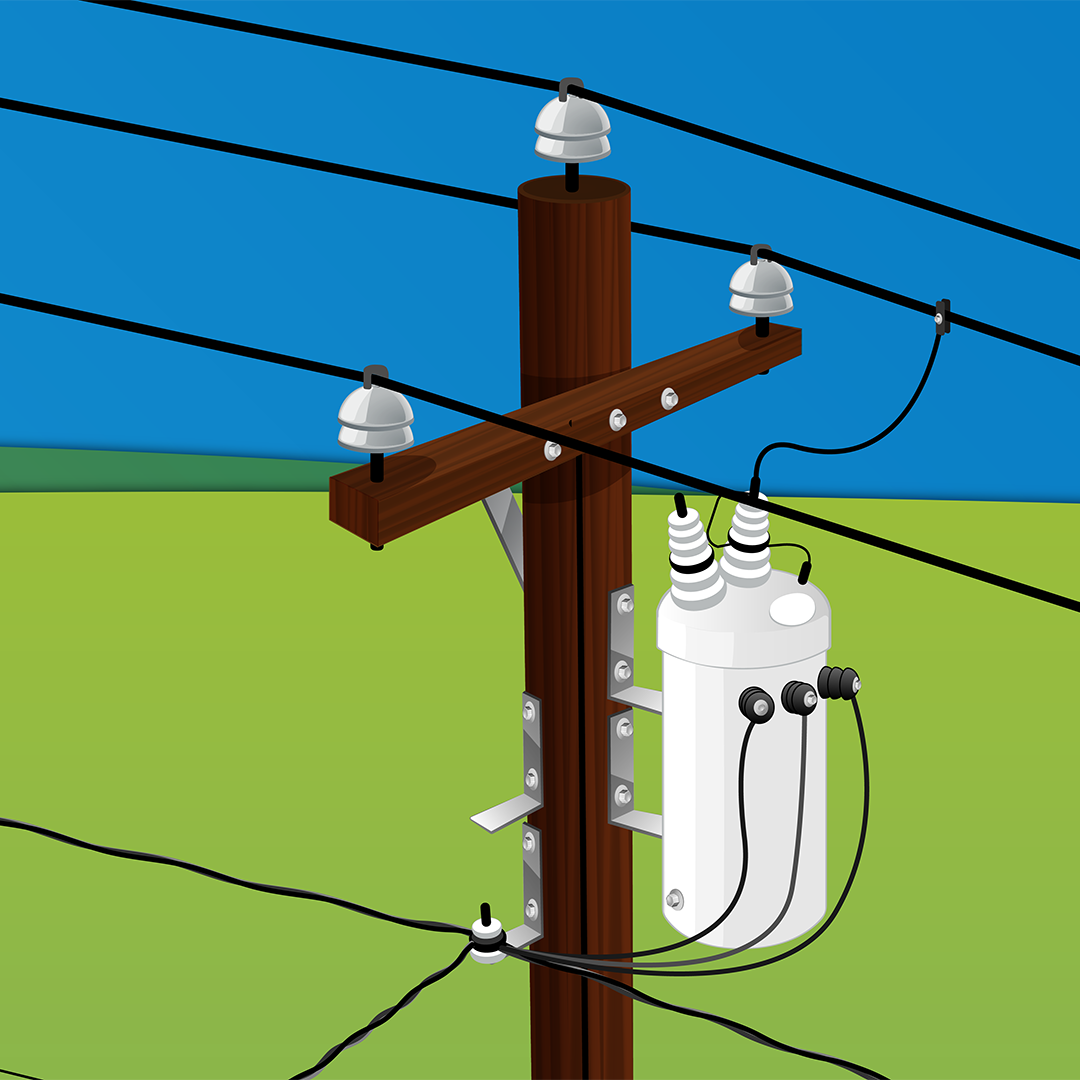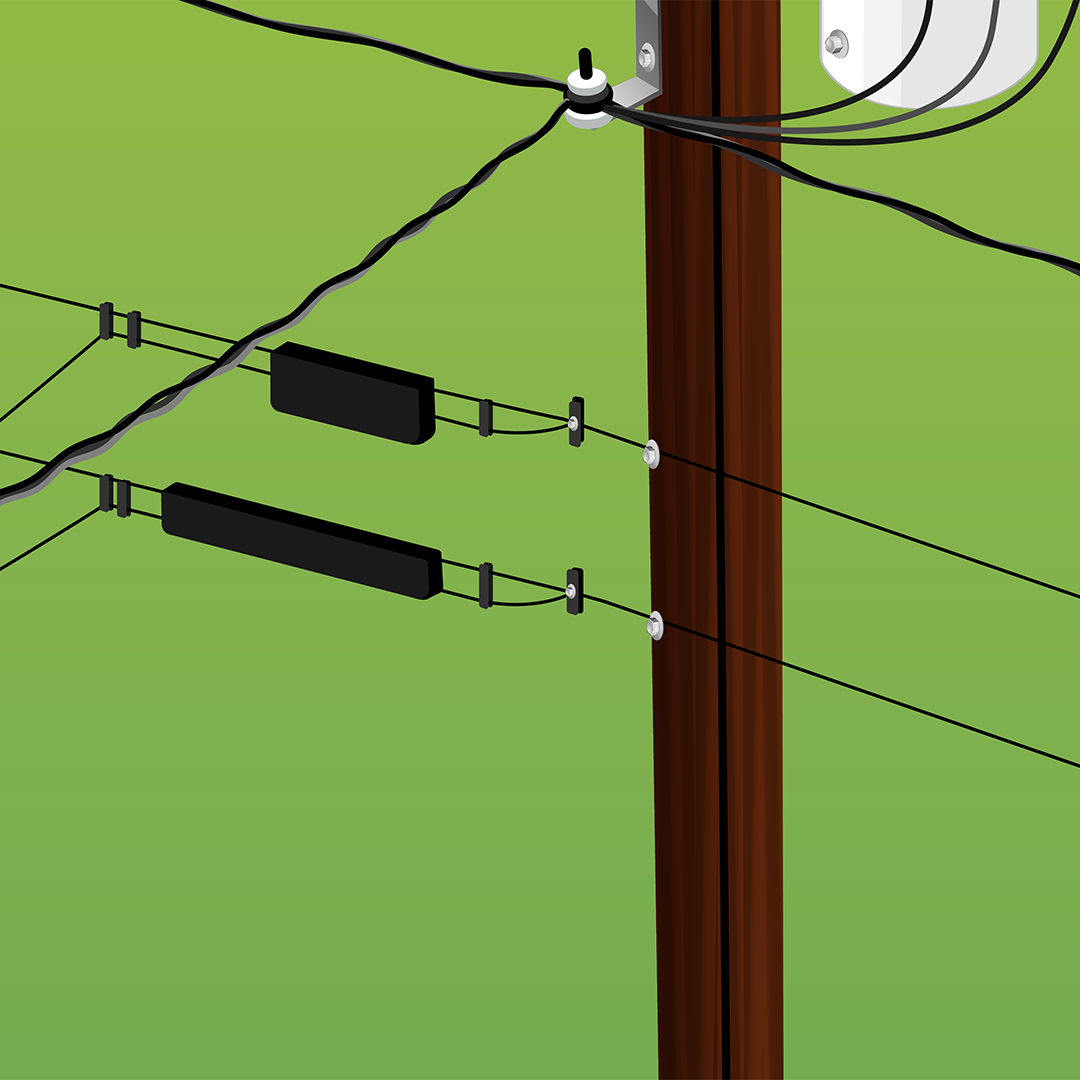Not All Equipment Belongs to Austin Energy
Learn the Difference Between Power Lines and Communications Lines
Austin Energy works 24/7 to safely deliver power, but not all of the equipment we interact with is our responsibility to maintain and repair. Here’s a high-level look at what belongs to Austin Energy and what belongs to others.
What’s What on Utility Poles
With more than 12,200 miles of power lines and more than 160,000 power poles, there’s a good chance the utility poles you see around the area are managed and maintained by Austin Energy. Though the utility operates the electrical equipment at the top of poles, not everything attached there falls under Austin Energy’s responsibility. Here’s a general look at what goes on a utility pole and who’s responsible for it.

- Primary wires (managed and maintained by Austin Energy) are generally attached on top of the utility pole and carry high-voltage power from the substation to the community.
- Insulators (managed and maintained by Austin Energy) hold the energized wires in place, preventing the wires from contacting the pole or structure.
- Transformers (managed and maintained by Austin Energy) convert the high voltage from the primary wires to lower voltage for use by residents and businesses.
- Secondary wires (managed and maintained by Austin Energy) carry the lower-voltage power and connect it to homes and businesses.
- Telephone, cable and fiber lines — communications lines — are typically the lowest wires on a utility pole. Though these are often attached to Austin Energy poles, the utility does not maintain or trim trees around this equipment. Communication service providers are responsible for maintaining their equipment and poles.
Download the What’s What on Utility Poles graphic (pdf)
The Difference Between Power Lines and Communications Lines

Power Lines:
- Will always be near the top of the pole.
- Will have insulators that protect wires and equipment.
- Will sometimes include a transformer that reduces voltage before electricity is delivered to customers.
- Should always be considered energized and dangerous.

Communication Lines:
- Will usually be 40 inches or more below the power lines and electric equipment.
- Will often include communications wires and equipment such as a splicer box, loops of wires or slackened wiring.
- Are generally not as dangerous as power lines.
- If downed or in disrepair, should be reported immediately to expedite repairs.
To report issues or violations with communications lines, email Pole Attachment Operations.
Be Safe! Never Go Near Downed Power Lines
If there is immediate danger, call 9-1-1. Report all downed power lines, trees, or tree limbs touching power lines by calling Austin Energy at 512-322-9100.
What’s Ours, What’s Yours: Residential Electric Service
Above-Ground Residential Electric Service
This shows who is responsible for the various parts of the above-ground residential electric system.

- Service Drop (managed and maintained by Austin Energy): Austin Energy repairs the wire that runs to your home, but we do not trim trees along the service drop. We will shut off the power at your request so trees can be trimmed safely.
- Point of Attachment (managed and maintained by the customer): You are responsible for the anchor that attaches the service drop to your home.
- Service Entrance Cable (managed and maintained by the customer): You are responsible for the wire that runs along the outside of your home into the meter and from the meter to your service panel or fuse box.
- Meter (managed and maintained by Austin Energy): Austin Energy owns the meter(s) that measures electricity use or solar production.
- Meter Base (managed and maintained by the customer): You are responsible for the metal box that houses the meter.
- Service Panel or Fuse Box (managed and maintained by the customer): You are responsible for the box(es), the circuit breakers or fuses, and all of the wiring in your home.
- Solar/Battery (managed and maintained by the customer): You are responsible for any solar equipment or home battery storage system.
Download the Above-Ground Electric Service graphic (pdf)
Underground Residential Electric Service
This shows who is responsible for the various parts of the underground residential electric system.

- Meter (managed and maintained by Austin Energy): Austin Energy owns/maintains the meter(s) that measure electricity use or solar production.
- Meter Base (managed and maintained by the customer): You own/maintain the metal box that houses the meter (meter base).
- Service Panel or Fuse Box (managed and maintained by the customer): You are responsible for the box(es), the circuit breakers or fuses, and all of the wiring in your home.
- Customer Conduit (managed and maintained by the customer): You own/maintain the conduit from the meter base to where it enters the transformer.
- Cable Inside Conduit (managed and maintained by Austin Energy): Austin Energy owns and maintains the cable inside the conduit from the transformer to the meter base.
- Transformer (managed and maintained by Austin Energy): Austin Energy owns and maintains the transformer mounted on the pad.
- Austin Energy Conduit (managed and maintained by Austin Energy): Austin Energy owns/maintains the conduit and cable from the transformer back to the source.
- Solar/Battery (managed and maintained by the customer): You are responsible for any solar equipment or home battery storage system.
Download the Underground Electric Service graphic (pdf)
